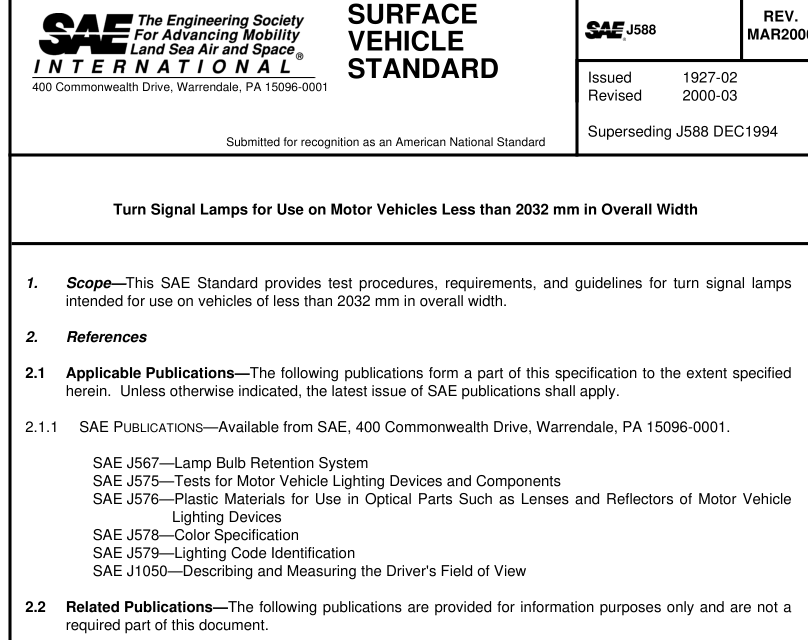SAE J588:2000 pdf download Turn Signal Lamps for Use on Motor Vehicles Less than 2032 mm in Overall Width
6. Requirements
6.1 Performance Requirements—A device when tested in accordance with the test procedures specified in Section 5, shall meet the following requirements:
6.1 .1 V IBRATION —SAE J575
6.1 .2 M OISTURE —SAE J575
6.1 .3 D UST —SAE J575
6.1 .4 C ORROSION —SAE J575
6.1 .5 P HOTOMETRY —SAE J575
6.1.5.1 The lamp shall be designed to conform to the zone total photometric requirements of Tables 1 A and 1 B and its footnotes. The summation of the luminous intensity measurements at the test points in a zone shall be at least the value shown.
6.1.5.2 A multiple compartment lamp or multiple lamps may be used to meet the photometric requirements of a turn signal lamp. If a multiple compartment or multiple lamps are used and the distance between adjacent light sources does not exceed 560 mm for two compartments or lamp arrangements and does not exceed 41 0 mm for three compartments or lamp arrangements, then the combination of the compartments or lamps must be used to meet the photometric requirements for the corresponding number of lighted sections see Tables 1 A and 1 B. If the distance between adjacent light sources exceeds the previous dimensions, each compartment or lamp shall comply with the photometric requirements for one lighted section (see Tables 1 A and 1 B.)
6.1.5.3 When a tail lamp or parking lamp is combined with the turn signal lamp, the signal lamp shall not be less than three times the luminous intensity (a) of the tail lamp at any test point, or (b) of the parking lamp at any test point on or above horizontal except that at H-V, H-5L, H-5R, and 5U-V, the signal lamp shall not be less than five times the luminous intensity of the tail lamp or parking lamp. If a multiple compartment or multiple lamp arrangement is used and the distance between optical axis for both the tail lamp (parking lamp) and the turn signal is within the dimensions specified in 6.1 .5.2, the ratio of the signal to the tail lamp (parking lamp) shall be computed with all the compartments or lamps lighted. If a multiple compartment or multiple lamp arrangement is used and the distance between optical axis for one of the functions exceeds the dimensions specified in 6.1 .5.2, the ratio shall be computed for only those compartments or lamps where the tail lamp (parking lamp) and turn signal are optically combined. Where the tail lamp is combined with the turn signal lamp, and the maximum luminous intensity of the tail lamp is located below horizontal and within an area generated by a 0.5 degree radius around a test point, the ratio for the test point may be computed using the lowest value of the tail lamp luminous intensity within the generated area.
6.1.5.4 In the case where the front turn signal is mounted in close proximity to the low beam headlamp or any additional lamp used to supplement or used in lieu of the low beam, such as an auxiliary low beam or fog lamp, Table 2 shall be used to modify Table 1 B as follows:
6.1 .5.4.1 Spacing for a direct light source type design front turn signal lamp, that is, a lamp primarily employing a lens to meet photometric requirements (for example, a lamp that does not employ a reflector) shall be measured from the light source to the lighted edge of the low beam headlamp or any additional lamp used to supplement or used in lieu of the lower beam, such as an auxiliary low beam or fog lamp.
SAE J588:2000 pdf download
